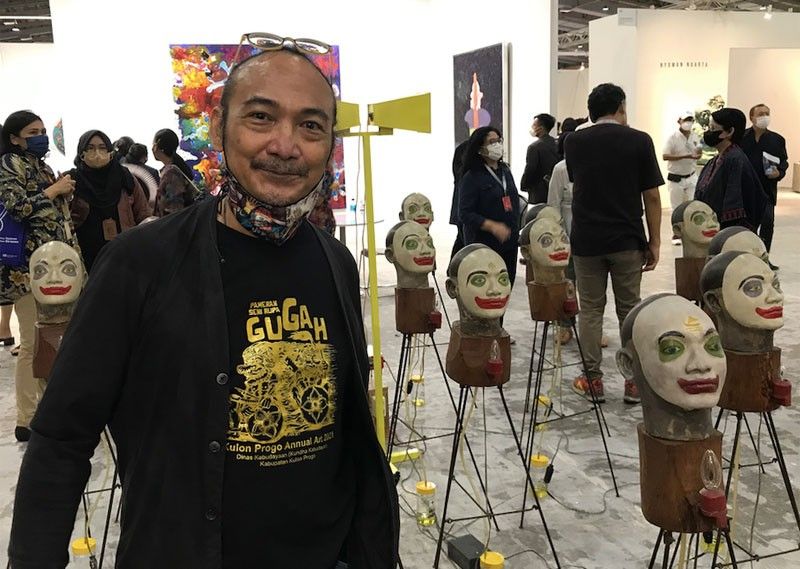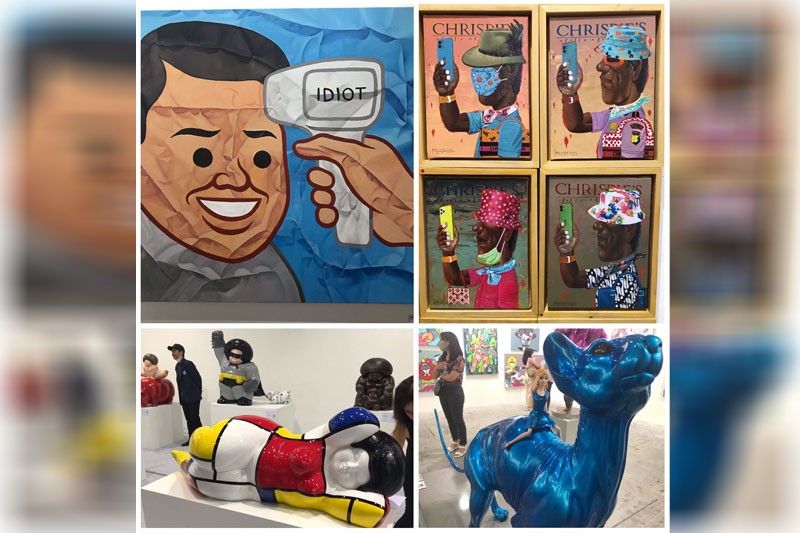Instagrammy moments in the Art Jakarta ecosystem

JAKARTA, Indonesia — In the ever-shifting landscape of art fairs, work that was once praised as “Instagrammable” is now dismissed as “Instagrammy” — pretty clickbait for the surface of a screen, great for posting selfies, but lacking depth.
There is some of that at Art Jakarta — with walls of transformed electric guitars by Soni Irawan, large resin cartoon figures from Museum of Toys, smooth Botero-like sculptures from Adi Gunawan, endlessly varying panels of selfie-taking faces decorating the mock cover of a “CHRISPIE’S” brochure — but dive deeper, and there are layers to peruse, stories to tell, mysteries to unfurl.
Art Jakarta (AJ) returned to Jakarta Convention Center from Aug. 26-28 after a two-year hiatus with a kickoff from fair director Tom Tandio, who called it a “testament to the willpower and endurance of the Indonesian art scene and all its stakeholders that we are still together to face a new situation.” Those stakeholders include artists, galleries and collectors, but also corporate sponsors like UOB Indonesia bank and Bibit investment group staging exhibits near the entrance walkway.
And really, the return of Jakarta’s biggest art event after two quiet years is the story: some 25,000 attendees pronounce a clear desire to return to public art-gazing, selfie-taking and collecting (with more young buyers fueling the market). Inside, 62 galleries, 23 from overseas, took over the large convention hall with a renewed focus on NFTs as well as Bali artists and other decentralized art outposts, large installations and smaller booths. The theme was really no theme at all: just a happy return to a live stage where art can converge and trade hands again.
As artistic director Enin Supriyanto said, launching AJ22, “I am happy and optimistic about the event. Our partners, whether galleries, businesses, fellow artists or collectors, are all eager to get involved and participate. It lifts our collective spirit. It is evidence that our art ecosystem is resilient and quick to recover.”
Here are highlights from this year’s Art Jakarta.

Coins in the fountain
As an appetizer, Bibit showed an ongoing work by Bali-based Marco Cassani, who retrieves coins thrown by well wishers into sacred Balinese fountains and stacks the corroded currency in tower form, thereby transforming its value from physical wealth tokens into something more spiritual: a wish. (That this work is then funded and displayed by an investment firm is another layer to contemplate.) There’s this year’s UOB Art Space first prize artwork, “Even After Death, the Departed Lives Life,” a collage painting by Meliantha Muliawan that collects used facemasks from the pandemic (she also held a children’s art workshop in the fair); and there’s a wooden sculpture by Sasya Tranggono, a local converted Christian artist, depicting the “Last Supper” participants as puppets ascending an upended dinner table towards Jesus. (“Let’s put everything upside down and chaotic,” an artist friend suggested to her, an effect she admits she much preferred.)
Spotted at AJ
Fifteen local artists presented works curated specifically for the opening fairground at Art Jakarta Spot, including Nidityo Adipurnomo, whose oversized rattan and pyrite hangings “Hair Bun from the Earth 3” and “Gender Artefact 2nd” conjure up natural forms that are somehow interchangeable with human attributes, exploring gender fluidity and the eroticism of memory; another artist working with woven forms is Jogja-based Mulyana, who injects his digital cartoon creation into crocheted corals that are executed by women weaving communities; Daniel Kho’s witty (and yes, Instagrammable) “Mobile” consisting of fantastical acrylic-on-wood carved creatures suspended in row upon row, a reflection on spiritual versus physical reality; and the more metaphorical installation of Jompet Kuswidananto (“Rijsttafel Apocalypse”) which looks at the defiance of Dutch colonialism through buried symbols of Indonesian mythology and mysticism. (Those wolf masks.)
Life on the fairground
For Indo artist Heri Dono, whose installation “Political Clowns” shows us rows of carved clown heads drawing (electrical and actual) power from the underclass through piss-collecting tubes (“urine energy”), the cycle of change only leads to more of the same. During Suharto’s reign, Dono’s work, focusing on economic exploitation and repression, was forced abroad, including to Manila where, despite martial law, it was well received (“People there are more interested in talking about these issues”). After Suharto stepped down in 1998, the artist focused on Javanese wayang (shadow) puppetry figures to make his overt political commentary; he can only shake his head at the election of another Marcos in our midst — proof of his theory that political dynasties are merely churning cycles of maintaining power.
At the center of the fairground is Dedris Sufriadi’s mountain of pulped paperback books (“Building a New Indonesian Literacy”) crafted by the artist into a circular booth that invites people to enter and, inevitably, have their photo taken. It became one of the festival’s most Instagrammed spots, rendering the written word — the artist’s true concern — back to something that was, again, merely surface background for endless selfies.
Amid the explosions of Instagrammy art we find Vinyl On Vinyl, the sole Manila gallery outlier at AJ this year. As gallery founder (and Formula 3 racecar driver) Gaby de la Merced explains, “We are taking things slower, but it’s really good to be here.” Their booth is showing Reen Barrera, whose Ohlala boy and Duge dog characters — crafted from wooden scraps recovered from church statues — have hit internationally, including the US and Paris. The details of Barrera’s work — stories drawn from his life, literally etched into the carved faces of Ohlala — speak of the artist’s journey, and probe a bit deeper than superficial cartoon art does.
At the opposite end of the floor is ROH Salon, a space showing, among others, two other Filipino artists — Gary-Ross Pastrana, whose work, like the robot dog sculpture on display, blurs photography, sculpture and performance art; and Kristoffer Ardeña, whose “Ghost Paintings” arise from household waste applied to tarp, layered with paint, then weathered to the point of cracking (he also works with discarded election campaign posters, so there’s lots of available waste to work with). Both come to the Indonesian gallery, run by young Jun Tirtadji, through his past interactions with Manila’s Silverlens Gallery.
ROH Projects is one of the most intriguing new galleries in Jakarta. At their other booth this year, Indonesians Agung Kurniawan, Banny Jayanata and Thai artist Kawita Vatanajyankur explore human form through the lens of, respectively, political history, figurative contemplation and consumption (Kawita’s disturbing videos show nude figures dipped into cleaning products and basins). Many of ROH Projects’ installments delve into the interaction of rhythmic processes and cycles, using elaborate sound design that is multilayered and immersive; we’ll feature more in a future article.
NFTs are here to stay
AJ already got an early start on non-fungible tokens (NFTs) last April, launching an outdoor installation at Art Jakarta Gardens in Hutan Kota by Plataran, a large, leafy environment in the middle of the city (think Makati’s Ayala Triangle Gardens, but much bigger). But inside the convention center, they went deeper behind the scenes — literally behind a curtain, where a table of creators from Indonesian launchpad Gaspack did a live NFT “pre-minting” session in a dark interior room: an artist hunches over a sketchpad, a man clicks a laptop nearby, scanning, uploading images; loud punk music plays, a guitar leans against a wall, and crude video cams capture us watching it all. Is it all just for show? If art is being minted and we don’t see it, does it even exist?
Through another curtain, there’s a gauzy display from thisPLAY Studio, where artist collective Blanco Benz Atelier beams a self-generating fractal video across walls of taffeta — or, as they describe it, “a decentralized virtual black market wrapped and molded around historical futurism, which explores blockchain technology and the breeding mechanism.”
Art Jakarta is clearly committed to exploring where NFTs and physical art can merge, though sometimes it feels like groping around (literally) in the dark. The result, for art fairs, can be less than game-changing: several booths with printed-out NFTs or basic screens showing some variations on the artwork; a lot of time spent just explaining what’s going on to a skeptical public. Incentives — like signed, printed-out copies of the work — are baked in to keep young viewers interested. Collectibility drives it all, which is never the purest artistic motivation.
Somewhere in there, the real artists may benefit a bit more than from a gallery system or being out on their own. But I’ve yet to see NFTs fully integrated into a physical art space that utilizes all of its layers — salesmanship, performance, physical and digital art — into something that truly blows us away.
Until then, as Art Jakarta 2022 shows us, it will remain an ongoing dialogue between layers and surfaces, Instagram and galleries, physical and phygital.

* * *
For further details visit www.artjakarta.com.



















